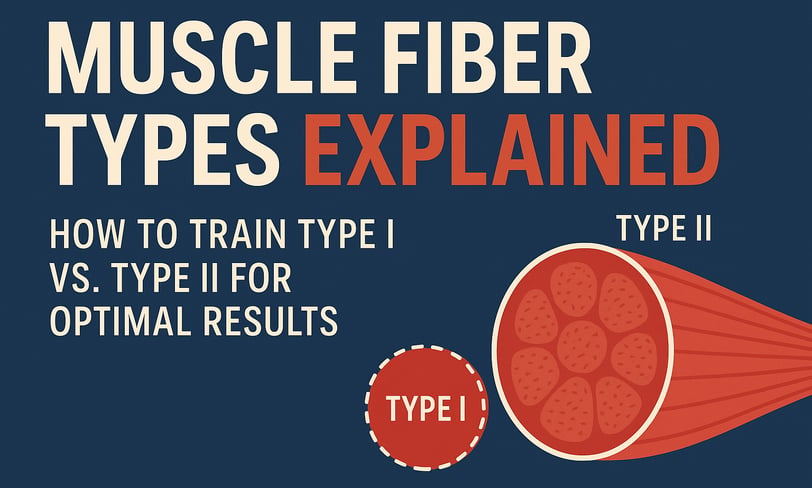Muscle Fiber Types Explained: How to Train Type I vs. Type II for Optimal Results
Unlock peak performance by understanding the difference between Type I and Type II muscle fibers. Learn how to train each fiber type for strength, endurance, and recovery—plus expert tips and essential tools to take your fitness to the next level.
5/14/20253 min read


Understanding Muscle Fiber Types for Training Optimization
Delve into Type I vs. Type II Fibers and Their Training Implications
When it comes to improving strength, endurance, and performance, many overlook a foundational element of human physiology: muscle fiber types. Skeletal muscles are not all the same. In fact, the body contains different fibers—Type I (slow-twitch) and Type II (fast-twitch)—each specialized for different tasks.
Understanding these fibers and how they respond to various types of training can completely reshape how you build muscle, boost endurance, and prevent plateaus. Let’s break it down, supported by science and expert-backed training strategies.
The Science of Muscle Fibers
Muscle fibers fall into two main categories:
Type I (Slow-Twitch): These fibers are built for endurance. They contract slowly, resist fatigue, and rely on oxygen-rich, aerobic energy systems. They're ideal for long-distance running, cycling, or any low-intensity, high-duration activity.
Type II (Fast-Twitch): These are the explosive powerhouses. Subdivided into Type IIa (intermediate) and Type IIx (purely anaerobic), these fibers contract quickly and with force. They're perfect for weightlifting, sprinting, and HIIT-style workouts—but fatigue more rapidly.
Your unique fiber distribution is partially genetic, but training style influences how they perform and adapt over time.
How to Train Each Fiber Type
If you’re training for endurance, your program should favor steady-state cardio, bodyweight circuits, or high-rep, low-weight strength work. That’s how you target Type I fibers.
If you're chasing size, speed, or explosive power, you’ll need heavy resistance training, plyometrics, or sprints to really tap into Type II fibers.
Elite trainers often recommend periodization—a rotating approach that cycles through different phases (like endurance, hypertrophy, strength, and power) to train all fibers and avoid plateaus.
-TheraBand Resistance Band Set
Best For: Type I (slow-twitch) endurance training
Why It Works: These bands apply consistent, low-to-moderate resistance—ideal for long time-under-tension workouts that stimulate Type I fibers and promote muscle tone and joint stability. They’re also compact, making them perfect for warm-ups and recovery.
Amazon Link : https://amzn.to/3EVxKfE
Recovery: Where Growth Actually Happens
Training creates microscopic damage in your muscle tissue—recovery is where it rebuilds stronger. This is especially true when training fast-twitch fibers, which require more time and nutrients to recover due to the high force output.
Sleep, hydration, mobility work, and protein intake all play crucial roles in giving both fiber types what they need to grow and perform.
-Optimum Nutrition Gold Standard 100% Whey Protein
Best For: Recovery for both Type I & II fibers
Why It Works: Protein is essential for muscle repair. This whey formula absorbs quickly, delivering amino acids right when your muscles need them most—post-workout. It’s especially effective after explosive or strength-based sessions that heavily recruit Type II fibers.
Amazon Link : https://amzn.to/4j0WrFr
Blending the Best of Both Worlds
A complete program should incorporate both fiber types:
Try mixing heavy lifts (Type II) with active rest (Type I)—like supersets of squats and jump rope.
Alternate between power days and endurance days.
Use cross-training: a sprint day followed by yoga or cycling can activate different systems while avoiding burnout.
This mixed approach also increases metabolic flexibility, keeps training fun, and supports long-term gains.
-Bowflex SelectTech 552 Adjustable Dumbbells
Best For: Strength & hypertrophy (Type II fiber activation)
Why It Works: These dumbbells let you scale from light to heavy weight quickly, supporting both endurance-based rep ranges and explosive strength sets. Perfect for periodization or full-body routines where you alternate between fiber types.
Affiliate Link Placeholder: https://amzn.to/42VO35g
Final Thoughts
Knowing whether you’re training slow-twitch or fast-twitch muscle fibers—and why—can help you build smarter, not harder. You’ll waste less time, avoid injury, and see results aligned with your goals.
Whether you’re an endurance athlete, strength junkie, or somewhere in between, balancing your training with intention—and using the right tools to support it—will help you unlock your full performance potential.
FITNESS
Nutrition
WellnesS
info@movebetterco.com
© 2025. All rights reserved | Privacy Policy | Terms & Conditions